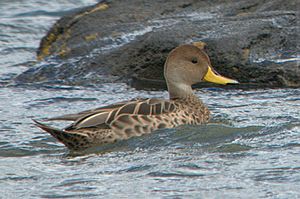Chilean pintail facts for kids
The Chilean pintail (Anas georgica spinicauda) is a type of duck. It's also known as the golden peck duck or brown pintail. This duck is a subspecies of the yellow-billed pintail. It belongs to a group of ducks called dabbling ducks, which means they feed by tipping their bodies forward in the water. In Spanish, people call it pato jergón grande, pato maicero, or pato piquidorado. In Portuguese, it's known as marreca-parda or marreca-danada.
Quick facts for kids Chilean pintail |
|
|---|---|
 |
|
| In Patagonia | |
| Scientific classification |
|
| Kingdom: | Animalia |
| Phylum: | Chordata |
| Class: | Aves |
| Order: | Anseriformes |
| Family: | Anatidae |
| Genus: | Anas |
| Species: | |
| Subspecies: |
A. g. spinicauda
|
| Trinomial name | |
| Anas georgica spinicauda Vieillot, 1816
|
|
| Synonyms | |
|
|
Contents
Where Do Chilean Pintails Live?
The Chilean pintail is one of three types of yellow-billed pintails. It is the most common and can be found in many places. You can see them across much of South America. Their range goes from southern Colombia all the way down to Tierra del Fuego. They also live in the Falkland Islands.
The other two types are the smaller South Georgia pintail and the extinct Niceforo's pintail. The South Georgia pintail lives only on the island of South Georgia. The Niceforo's pintail used to live in central Colombia but is now gone forever.
Chilean Pintail Habitats
Chilean pintails like to live near fresh water. They can be found in lakes, rivers, marshes, and lagoons. They also enjoy flooded meadows. These ducks can live in high places, up to 4,600 meters (about 15,000 feet) above sea level. This includes the high mountain areas of the Andes called the puna zone.
Ducks living in the northern parts of their range usually stay in one place. However, those further south fly north for the winter. They might travel as far as southern Brazil to find warmer weather.
What Do Chilean Pintails Look Like?
Chilean pintails are medium-sized ducks. They are about 65 centimeters (25 inches) long. Male pintails usually weigh between 740 and 830 grams (1.6 to 1.8 pounds). Females are a bit lighter, weighing 660 to 770 grams (1.4 to 1.7 pounds).
Their head and neck are brown with small black spots. Their throat and the front of their neck are lighter in color. The rest of their body is mostly buff-brown. The feathers have dark centers, making their chest look spotted. Their underside is paler.
The feathers on their upper body are brown-black with buff-colored edges. Their wings are grey-brown. The larger feathers on their wings have buff tips. The secondary feathers, which are important for flight, are shiny black with buff tips. This shiny black patch on their wing is called a speculum. It also has buff edges.
Female pintails look very similar to males. They are just a little bit duller in color. Young pintails, called juveniles, look like the adults. However, they are greyer and have streaks on their chest and underside. Chilean pintails are generally lighter in color than Niceforo's pintail. They are also greyer and much larger than the South Georgia pintail.
How Do Chilean Pintails Raise Their Young?
Chilean pintails have different breeding seasons depending on where they live. In the southern parts of their range, they start breeding from October to December. In the north, like in Peru, they breed from August to March.
The eggs are usually cream to pale pinkish in color. They are about 56 millimeters (2.2 inches) long and 40 millimeters (1.6 inches) wide. Each egg weighs about 42 grams (1.5 ounces). The mother duck sits on the eggs for about 26 days. This is called incubation. After the ducklings hatch, it takes them about 45 to 60 days to grow enough to fly. This is called fledging.
See also


